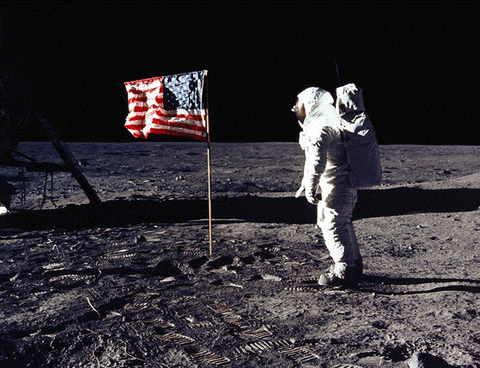HISTORY
By: Ayaan Atif
October 25th, 2023
The 1955 Space Race: Its Enduring Impact on Modern Space Technology and Travel
"The cosmos, the new frontier; the stars, the new prizes in the ongoing Cold War rivalry." — President John F. Kennedy

This gif depicts how the future looks like with humans reaching different parts of the infinite cosmos (Gif Credit: The Wall Street Journal)
In the wake of World War II, the world was undergoing a seismic shift in the realms of science, technology, and politics. It was in this transformative atmosphere that the Space Race emerged, marking the beginning of a historical rivalry that would forever reshape human civilization. The stage was set in 1955, as two superpowers, the United States and the Soviet Union, cast their ambitions skyward, engaging in a race to conquer the cosmos. This marked the inception of a competition that would not only redefine space exploration but also revolutionize modern space technology and travel.
The backdrop for the Space Race was the Cold War, a period of intense political and ideological rivalry between the United States and the Soviet Union. The specter of a nuclear conflict loomed large, and each nation sought to establish its dominance not only on Earth but in the uncharted territories of space. It was within this intense geopolitical context that the competition for space exploration took flight.
Capturing the German Rocket Technology
Crucial to the unfolding of the Space Race was the exploitation of captured German rocket technology at the end of World War II. Both nations recognized the potential of these advances in rocketry. This technology, which had propelled the destructive V-2 rockets, was now seen as the key to reaching the stars. With their sights set on the cosmos, the United States and the Soviet Union harnessed this knowledge as a means to secure their dominance and advance the frontiers of human knowledge.

The V2 rocket was the world's first large-scale liquid-propellant rocket, developed between 1936 and 1942 in Nazi Germany. It is regarded as a revolutionary breakthrough in rocket technology, with the use of liquid fuel increasing its thrust capabilities and making it the first artificial object to enter space.
At the heart of the Soviet Union's endeavors was the genius of Sergei Korolev, a visionary scientist and engineer. He was the mastermind behind the development of the first ballistic rocket, a pivotal milestone that set the stage for the Space Race. Korolev's tireless work and unrelenting ambition paved the way for the remarkable achievements that followed. It was his ingenuity and leadership that would guide the Soviet Union to be the first to reach space with the launch of Sputnik 1, marking a significant turning point in the competition.
As with any remarkable achievement of the past, the ISS has reached a juncture where its continued operation is marred with various challenges. One of the primary motivating factors behind its retirement is the mounting cost of maintenance. As the station ages and more time passes, the capital required to ensure its safety and functionality has multiplied significantly, straining the resource reserves of the participating agencies, such as JAXA and ESA. The fact of the matter is that the ISS was designed with a 15-year lifespan in mind, and it has well exceeded that limit, being in near-constant occupation since November 2000. Every new year it remains in orbit above our skies, it continually exceeds expectations even further. However, as is the case with any machine, it will not last forever.
Shockwaves of Sputnik (1957)
The turning point in the Space Race was the Soviet Union's launch of Sputnik 1 in 1957. This historic event sent shockwaves throughout the United States, not only symbolizing the Soviet lead but also demonstrating their capability to launch an artificial satellite into space. The beeping of Sputnik 1's radio transmitters was not just a technological feat; it was a clear indication of Soviet prowess in rocketry and satellite technology. The launch sent waves of concern and urgency across the United States and the rest of the world, setting in motion a sequence of events that would define the Space Race.
NASA and American Response (1958)
In response to the Soviet Union's early successes, the United States took a bold step by establishing the National Aeronautics and Space Administration (NASA) in 1958. NASA was conceived with a clear mission: to not only surpass the Soviet Union in space exploration but also to cultivate technological advancements that would have far-reaching implications for both military and civilian applications. The establishment of NASA marked a commitment to space exploration that transcended national boundaries, ushering in a new era of scientific and technological development.

Few moments in Rice’s history are as well known or oft remarked upon as the 1962 speech in which President John F. Kennedy boldly declared, “We choose to go to the moon!” (Photo Credits: NASA)
On September 12, 1962, President Kennedy delivered a seminal speech at Rice University Stadium, setting an ambitious goal for Americans in the midst of the space race: to land a human on the moon through the Apollo Program. Kennedy's famous words, "We choose to go to the Moon" at the beginning of this decade, not because it is easy, but because it is hard, because that goal will unite and harness the finest of our efforts and abilities," as recorded by the JFK Library, left an indelible mark on the nation.
This speech followed an earlier address to Congress on May 25, 1961, prompted by Yuri Gagarin's historic spaceflight, as detailed by the Smithsonian National Air and Space Museum. Kennedy's resolute words led to an 89% increase in NASA's budget, signifying a shift towards a singular long-term mission: reaching the moon, even as short-term victories and advancements continued to unfold. "The space race was a race to the moon," noted Odom. Kennedy's goal was to be the first to reach the moon, a monumental feat with vast propaganda potential. It was a pivotal contest during the Cold War, as many nations in the global South gained independence and faced the choice between the U.S. model of liberal democracy and the Soviet system of communism. Kennedy recognized that the moon race could serve as a powerful demonstration of American technological prowess and the virtues of one system over another.
Challenges and Halts in the Space Race
Despite the remarkable successes achieved during the Space Race, there were also notable setbacks, underscoring the formidable challenges inherent to space exploration. The journey beyond our planet's boundaries was fraught with danger, and this was evident from several tragic incidents. On January 27, 1967, a somber day in the history of the U.S. space program, disaster struck during a simulated launch for the first lunar module, Apollo 1. A flash fire broke out, resulting in the tragic loss of the mission's crew, which included astronauts Gus Grissom, Ed White, and Roger B. Chaffee. This devastating event served as a stark reminder of the hazards associated with space travel.
Tragedy was not exclusive to the American space program. The Soviet Union also experienced a profound loss during this period. On April 24, 1967, Soviet Cosmonaut Vladimir Komarov tragically lost his life during the Soyuz 1 mission. The spacecraft's parachute became tangled during re-entry, leading to a fatal crash.

Among the rare post-Soviet era photographs, this poignant image reveals the crash site of Soyuz 1. Within the fiery wreckage of twisted metal, lies the poignant reminder of the first human loss in space exploration. (Image Credits: Roscosmos)
These incidents illustrated the formidable difficulties and perils faced by early astronauts and space programs. The early pioneers in space exploration had to grapple with developing entirely new systems and technologies while entrusting human lives to rockets initially designed for nuclear delivery. The hazards and challenges encountered during these formative years serve as a lasting testament to the courage and dedication of those who ventured into the unknown. As space exploration continued to advance over the decades, significant lessons were learned, and technologies evolved. However, as space expert Odom aptly notes, the endeavor of space exploration never became any less complex or risky. The challenges of the early Space Race years remain relevant today, emphasizing that while we have made great strides in our understanding of space, we must always respect the inherent challenges of venturing beyond our home planet.
Apollo Program and Lunar Legacy

The Apollo 11 moon landing on July 20, 1969 was one of the most astonishing achievements in human history. That day, an estimated 530 million TV viewers watched U.S. astronauts Neil Armstrong and Buzz Aldrin take their first steps on the moon. (Photo Credit: NASA)
Capturing the German Rocket Technology
"The first human footsteps on the lunar surface were not just small steps for mankind; they were giant leaps for human potential and exploration." — Astronaut Michael Collins
The crowning achievement of the Space Race was the Apollo program, culminating in the first human moon landing in 1969. This historic mission was not just a symbol of American triumph but a testament to the indomitable spirit of human exploration. The Apollo missions broadened our understanding of the universe, bringing back invaluable knowledge about the moon and space itself. The first human footsteps on the lunar surface were an iconic moment in history, witnessed by millions around the world. The legacy of Apollo extends beyond its groundbreaking scientific achievements; it inspires future generations to dream big and reach for the stars. This monumental event united people across the globe in awe and optimism, emphasizing the boundless potential of human achievement and international cooperation, which remains a shining example of what humanity can accomplish when united by a shared vision.
The Modern Space Industry
"The first human footsteps on the lunar surface were not just small steps for mankind; they were giant leaps for human potential and exploration." — Astronaut Michael Collins
The lasting impact of the 1955 Space Race is vividly evident in the modern space industry. Today, commercial space ventures, epitomized by companies like SpaceX and Blue Origin, are pioneering a new era of space travel. These endeavors are not only about exploration; they are about democratizing space and making it accessible to humanity at large. The technological achievements driven by the Space Race have transformed space from a realm of superpowers to a domain open to scientific exploration, private enterprise, and potential colonization. The competition that began in 1955 laid the foundation for a future where the cosmos is within reach for all of humanity.
Conclusion
The Space Race of 1955 was a pivotal chapter in human history, a race to the cosmos that reshaped space exploration and modern technology. This competition was not just about reaching the stars; it was about challenging the limits of human potential and redefining the boundaries of what we can achieve in the realm of space technology and travel. It continues to serve as an enduring source of inspiration, driving us toward new frontiers and a future where space is open to all who dare to explore.
Subscribe To Our Newsletter
Receive amazing space news and stories that are hot off the press and ready to be read by thousands of people all around the world.
